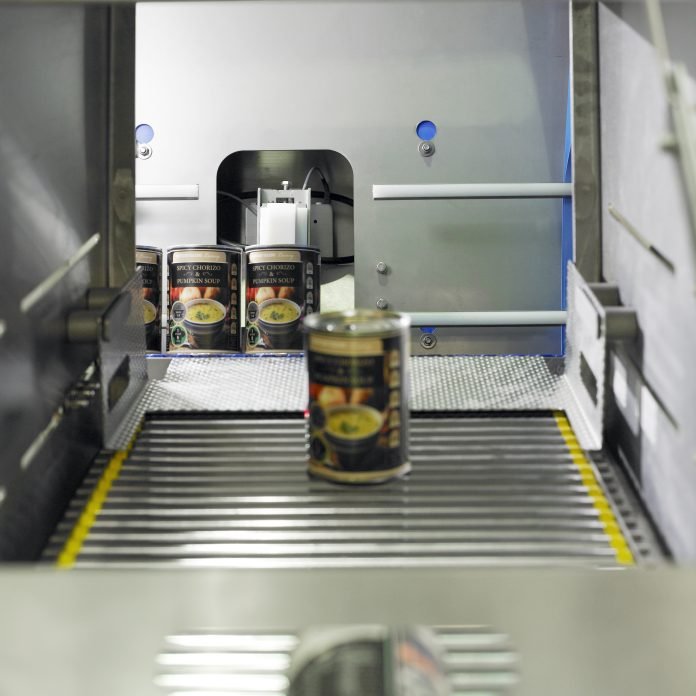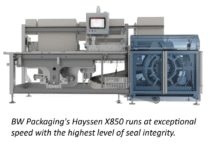
With thousands of cans rushing through production lines every hour, even the smallest defect can lead to costly recalls or damage brand reputation. Whether it’s canned soups, baked beans or tinned fish, x-ray inspection has become a game-changer, providing a reliable way to detect contaminants, verify product integrity and maintain compliance – all while combating rising costs. Mike Pipe, head of global sales and product management, Mettler-Toledo Safeline X-ray, writes.
The role of X-ray inspection in canning
X-ray technology provides a robust solution for detecting physical contaminants in metal cans, such as metal fragments, glass, mineral stones, calcified bone and dense plastics. In real-time, x-ray inspection systems identify foreign materials within the product itself, regardless of the packaging material. This makes them indispensable for maintaining high standards of food safety.
Beyond contamination detection, x-ray inspection supports quality control by monitoring fill levels, identifying missing components and detecting dented cans. The technology utilizes specific fill level tools to verify that products are at the correct levels. This avoids unnecessary and costly giveaway or disappointing the end user with an underfilled can. In canned soups, for example, x-ray inspection helps verify that the product is evenly filled, thereby preventing underfills that could lead to customer complaints or overfills that result in unnecessary product waste.
By incorporating x-ray systems into high-speed canning lines, manufacturers can detect issues early, improve operational efficiency and maintain compliance without incurring excessive costs.
Overcoming challenges in high-speed canning
High-speed canning presents unique inspection challenges due to the density and structure of metal cans. Their ribbed walls, tiered bases and pull tabs can create areas where contaminants might be obscured. Traditional inspection methods often face limitations when dealing with these complexities at high line speeds.
X-ray systems provide an advanced solution by offering superior detection accuracy without being impacted by the type of packaging, i.e. metal. With the ability to scan through the entire can, modern x-ray machines can identify contaminants that might otherwise go unnoticed.
These systems also support additional quality control measures, such as verifying seal integrity, monitoring fill levels and identifying dents or deformations that could impact product quality. This is particularly crucial for high-value products such as premium canned fish, where consumer expectations are exceptionally high.
For manufacturers operating at high speeds, maintaining efficiency while upholding rigorous safety standards is paramount. The latest x-ray inspection technology not only meets these demands but also optimizes production by reducing false rejects, and minimising downtime through system features such as the correct reject systems. High-resolution imaging, adaptive filtering and automated rejection mechanisms all contribute to a seamless inspection process that aligns with the pace of modern canning operations.
Strategies for effective inspection
Manufacturers looking to enhance x-ray inspection capabilities must adopt strategies tailored to high-speed canning environments. The selection of the right system is crucial, as different beam orientations – vertical, horizontal or split-beam – affect detection accuracy. A well-chosen system will provide optimal imaging while accommodating the structural nuances of metal cans.
Optimizing product handling is equally vital. Correct spacing between cans on the production line can significantly reduce false rejects and enhance detection reliability. Some manufacturers have also found that inspecting cans before sterilization yields better results, as product movement and air bubbles can interfere with image clarity after processing.
Advancements in imaging technology are making a substantial difference in inspection efficiency. Adaptive filtering techniques now allow x-ray systems to remove background noise caused by can edges, which can often interfere with detection by creating false signals. By filtering out this interference, the system gains a clearer view of the product inside, improving visibility of potential contaminants. This significantly reduces false rejects while enhancing accuracy, meaning that real threats are reliably identified even at the fastest production speeds.
Rejecting faulty products without disrupting the line remains a key priority. High-speed short-stroke reject devices help remove defective cans quickly while preventing damage to adjacent products. Advanced reject confirmation sensors verify that faulty cans have been properly removed, while monitoring systems prevent production interruptions by signaling when reject receptacles are full. These features not only improve efficiency but also help combat rising costs by reducing waste and minimizing downtime.
Meeting Regulatory Demands
Global food safety regulations require manufacturers to implement rigorous inspection protocols to protect consumers and maintain product integrity. X-ray systems help businesses comply with key frameworks such as Hazard Analysis and Critical Control Points (HACCP) and Hazard Analysis and Risk-Based Preventive Controls (HARPC).
In addition, x-ray technology supports adherence to Global Food Safety Initiative (GFSI)-recognised standards, including:
- British Retail Consortium’s (BRC) Global Standard for Food Safety – covering food safety management and product integrity
- International Featured Standard for Food (IFS) – for product quality and safety through detailed auditing
- Safe Quality Food (SQF) – designed for companies seeking a rigorous, consistent approach to food safety management
- Food Safety System Certification (FSSC) 22000 – incorporating ISO-based food safety principles for a global framework
Regulatory compliance is not only about avoiding penalties but also about protecting brand reputation. With consumer trust heavily reliant on product safety, x-ray inspection provides manufacturers with a competitive edge by demonstrating commitment to the highest industry standards.
The Future of X-ray Inspection in Canning
As production speeds increase and regulatory requirements grow more stringent, x-ray inspection technology must evolve. Modern systems are designed to handle greater throughput without compromising accuracy. Enhanced software algorithms, including AI-enabled image processing, are improving contaminant recognition while reducing false rejects. The integration of smart data analytics enables real-time monitoring, predictive maintenance and continuous optimization of inspection processes.
The latest x-ray systems are also more adaptable, fitting seamlessly into existing production lines with minimal disruption. This flexibility allows manufacturers to upgrade inspection capabilities without extensive modifications, helping them manage costs more effectively.
Conclusion
X-ray inspection is a vital tool in high-speed canning, supporting manufacturers in their efforts to enhance product safety, maximize quality and meet regulatory requirements. By adopting the latest technology and refining inspection strategies, businesses can overcome industry challenges while combating rising costs. With advancements in x-ray imaging, rejection mechanisms and automation, manufacturers are well-positioned to maintain efficiency, reduce waste and deliver safe, high-quality products to consumers.
Mike Pipe is head of global sales and product management, Mettler-Toledo Safeline X-ray
IndiFoodBev — authentic, impactful and influential
An English-language food and beverage processing and packaging industry B2B platform in print and web, IndiFoodBev is in its third year of publication. It is said that the Indian food and beverage industries represent approximately US$ 900 billion in revenues which implies more than 20% of the country’s GDP. Eliminating the wastage on the farmside can help to deliver more protein to a higher number of the population apart from generating sizable exports. The savings in soil, seeds, water, fertilizer, energy and ultimately food and nutrition could be the most immense contribution that country is poised to make to the moderation of climate change.
To improve your marketing and grow sales to the food and beverage processing and packaging industry, talk to us. Our research and consulting company IppStar [www.ippstar.org] can assess your potential and addressable markets in light of the competition. We can discuss marketing, communication, and sales strategies for market entry and growth.
Suppliers and service providers with a strategy and budget for targeted marketing can discuss using our hybrid print, web, video, and social media channels to create brand recognition linked to market relevance. Our technical writers are ready to meet you and your customers for content.
The second largest producer of fruit and vegetables in the world is continuously expanding processing capacities and delivery systems with appropriate innovative technologies. We cover product and consumer trends, nutrition, processing, research, equipment and packaging from farm to thali. Get our 2025 media kit and recalibrate your role in this dynamic market. Enhance your visibility and relevance to existing markets and turn potential customers into conversations. Ask for a sample copy of our bi-monthly in print or our weekly IndiFoodBev eZine each Wednesday.
For editorial info@ippgroup.in — for advertisement ads1@ippgroup.in and for subscriptions subscription@ippgroup.in
Naresh Khanna – 10 February 2025
Subscribe Now











